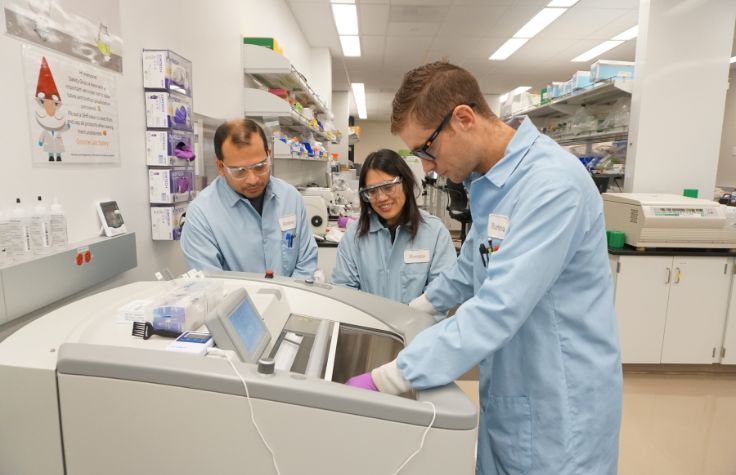
10 September 2025
While genomics has transformed cancer care and rare disease diagnosis, infectious disease testing is lagging behind with older methods. Often, physicians still have access only to limited or outdated technology that leaves them making decisions based on spotty or incomplete information.
For example, it’s not uncommon for a doctor to have a postoperative patient who’s suffering from signs of infection but whose cultures are negative. “That’s the point when physicians are the most stuck and left without any insight. They know their patient has an infection, but the culture is telling them they don’t,” says Nick Sanford, PhD, vice president of Medical Affairs at MicroGenDX. “So, they believe it must be a false negative because every other thing—the lab values, their 20 years’ experience as an MD—all adds up to infection, but their primary diagnostic tool is disagreeing with them.” From there, some clinicians turn to polymerase chain reaction (PCR) testing, which amplifies genetic material in the lab so it can be detected. But that method detects only the organisms whose primers are included on the particular panel used, limiting its ability to detect pathogens.
“The next logical step,” says Sanford, “is next-generation sequencing.” As implemented by MicroGenDX, each next-generation sequencing (NGS) test includes a standardized process for amplifying universal genes for bacteria and fungi.
Sanford oversees Medical Affairs at MicroGenDX, an American company that has processed more than a million NGS tests from across the country as well as internationally. In the US, they’ve signed agreements with more than 100 hospital systems just since January 2024, and this April they launched a sister company, MicroGenDX EU, to receive and run samples from abroad. MicroGenDX specializes in infectious disease research and clinical testing, often working with orthopedic surgeons, pulmonologists, neurologists (for central nervous system infections), and infectious disease specialists, among other experts.
The company recently upgraded the NGS technology in their Texas laboratory. Thanks to faster sequencing and analysis capabilities, they are reducing their sample-to-answer turnaround time from three to five days to 24 hours. They report being able to get excellent, clinical-grade data quality from a 12-hour run time, which helps them deliver results to doctors as soon as the next day after their lab receives a patient’s sample. “Now that’s diagnostics that can keep pace with clinical decision making in the hospital,” says Sanford. “With hospitals, the concern is always turnaround time.”
Who really benefits from faster NGS testing? Receiving a precise diagnosis and treatment means that patients with sepsis or acute infections could have shorter ICU stays, avoid complications, or prevent worsening illness. Their results support providers in creating targeted treatments that help patients recover from high-risk, debilitating conditions.
Elderly or catheterized patients suffering from recurrent UTIs could be matched with a targeted therapy, resolving symptoms faster and using fewer inappropriate antibiotics. Patients with a chronic illness might have fewer hospital visits or readmissions. Pediatric and immunocompromised patients could avoid staying in the hospital for days, waiting for results. Faster NGS testing also means lower health care expenses for families and general cost savings for hospitals and payers.
NGS is also increasingly being used in pulmonology and otolaryngology. MicroGenDX receives bronchoalveolar samples and nasal swabs from many patients who have been cycling through antibiotics for weeks. Identifying the responsible pathogens and drug resistance markers helps doctors intervene before the infections become chronic.
Sanford believes that, in the past, a three-to-five-day turnaround time caused doctors to consider NGS a last resort. But now that MicroGenDX has speedier lab processing, NGS testing is more attractive to providers. “Shortening that window to actionable data can mean the difference between a minor setback and a major complication,” he says.
Research and trials
MicroGenDX also conducts research on applications that are relevant to various critical care settings. The company just submitted a paper on a study evaluating 2000 synovial fluid samples from patients at risk of or with a chronic history of periprosthetic joint infection (PJI). “PJI is a mountain of an issue,” says Craig Tipton, PhD, MicroGenDX’s director of Biostatistics.
Tipton routinely hears concerns from both orthopedic surgeons and infectious disease physicians. “It takes so much of their bandwidth managing these very chronic infections,” he says. MicroGenDX has been able to show the superior sensitivity of NGS over other conventional diagnostic methods for microbiological testing, such as culture or quantitative-PCR-only testing. While this particular study did not have a direct comparator, they reported 76% sensitivity for NGS compared with 63% sensitivity from culture tests across a large meta-analysis and 41%–56% sensitivity for a commonly used qPCR panel.
“If you’re able to jump from 50% sensitivity to 76%, that’s another quarter of your patients for whom you suddenly now have actionable information with which to diagnose an infection, help guide treatment for that infection, and know whether you have to operate,” says Tipton. “Having all that extra information is huge.”
Sanford adds that de-escalation is another benefit. For instance, if a doctor suspects that an ICU patient has a fungal infection, they may start them on an expensive empiric antifungal therapy. However, armed with the answers provided by NGS, the doctor could de-escalate much faster and reduce the patient’s antimicrobial exposure, chance of side effects, and associated costs.
When you use only one method—and particularly only culture—you’re missing a huge spectrum of what could be there.
Starting this month, MicroGenDX will be participating in a trial led by Indiana University in 10 to 15 trauma hospitals across the United States. The participants will be patients who have undergone at least one surgery to try to heal a broken bone from a traumatic injury, and who have suspected fracture-related infection (FRI).
“Once an infection develops, the failure rate is extraordinarily high,” Tipton says. “And failure rates can lead to multiple surgeries trying to correct the issue and clear the infection. There are high costs with hospitalization, resource utilization, and high mortality rates—every metric you can think of.” MicroGenDX is partnering with the Major Extremity Trauma Research Consortium to coordinate the trial: In an intervention arm, patients will provide a sample for NGS. The researchers will compare the effects of incorporating NGS sampling at the time of revision surgery versus the current standard of care, which typically relies on conventional culture methods to inform treatment.
Under this standard protocol, doctors often can’t confirm an FRI diagnosis until they go into surgery, and they may have to wait days to do so by culture. Confirming a diagnosis enables them to discharge the patient and start them on a targeted therapy, if necessary.
The investigative team will follow patients for a year or more to monitor whether the earlier, more targeted therapy leads to faster healing, fewer surgeries, and other improvements. They’ll also track any findings that were missed by conventional diagnostics; if antibiotics are prescribed for an infection, they’ll track the medication’s management and any adverse effects.
The culture of culture
Both Tipton and Sanford are quick to note that the conventional culture test is still a useful tool, if an imperfect one. “We are not advocating at all for it to be taken out of the standard of care, but it has many limitations,” Tipton says. Conventional culture methods often miss an organism that doesn’t grow well in a culture dish, especially slow-growing pathogens that are anaerobes, fungi, or mycobacteria.
“When you use only one method—and particularly only culture—you’re missing a huge spectrum of what could be there,” says Tipton, who has noticed an uptick in orders for molecular diagnostic testing, including multiplex qPCR and NGS, to compensate for the lack of data from culture. In MicroGenDX's study of synovial fluid samples, they analyzed 467 of them that NGS had determined to be positive for PJI. And while qPCR can deliver rapid results, the study found that 44% of the dominant microbes reported in these samples were not included in a commonly used commercial multiplex qPCR panel for joint infection.
Dominant microbes are the most abundant organisms found in at least one patient sample; they are often considered priorities for treatment in an infected joint. Missing these microbes could spell disaster for patients if their infections go unconfirmed. “It would be very difficult to ever have a qPCR panel that could capture the crazy diversity of microbes that might be causing an infection,” Tipton says. “And although you do have some ability to detect anything via culture, in theory, we know that it misses everything that is difficult to grow in culture—and that’s even more difficult if the patients have been on antibiotics. If they’re on antibiotics, you may just not see anything that’s there.”
When they use NGS, MicroGenDX not only finds rare organisms they weren’t looking for, they find them in places no one would expect. For example, they’ve discovered the bacteria responsible for tuberculosis in synovial fluid, and Tropheryma whipplei in a lung biopsy, which aids diagnosis for atypical presentations of Whipple disease.
The MicroGenDX team frequently hears powerful accounts from people who have spent years visiting specialists, undergoing unhelpful tests and, at times, facing skepticism—all while living with debilitating pain. They often say that nothing worked for them, neither traditional nor nontraditional methods. But when NGS testing identifies the species causing their affliction, and they receive personalized treatment, their relief is immense.
As for those seasoned physicians scratching their heads at a negative culture result?
The tide is starting to turn. Professional organizations have begun amending their guidelines. In 2018, the International Consensus Meeting on Infection updated their guidelines for diagnosing periprosthetic joint infection with new formal statements advocating for NGS testing. In another instance, the Infectious Disease Society of America recently released new guidance statements on potential use cases for NGS.
“PCR works great when testing for COVID or screening a patient for Candida auris before going into surgery,” Sanford says, “But when just about anything that is a microbe could be causing your infection, I think a more agnostic method using NGS is where diagnostics will ultimately trend.”


